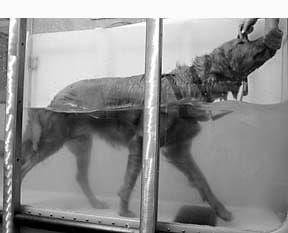-By C.C. Holland
Hydrotherapy and aquatic exercise are the hottest new tools in canine physical rehabilitation. And that’s not just a jump in a lake. Today’s cutting-edge therapists work with veterinarians’ referrals and use sophisticated underwater treadmills and other specialized equipment to provide rehabilitation for a variety of medical conditions. And they are frequently able to achieve better results in less time than through the recovery regimens prescribed by more conventional veterinary practitioners.
We reported on the rising use of heated therapy pools for rehabilitation in the October 2000 issue of WDJ, and described how therapists partially support and guide canine clients through a series of gentle exercises in the warm, muscle-relaxing water. The latest therapy tool also uses a warm pool, but adds an underwater treadmill. The therapist can effectively reduce the amount of body weight the dog must carry as he walks on the treadmill simply by increasing the depth of the water. As the dog progresses, the water height can be reduced to create more load on his limbs.

For example, in an underwater treadmill apparatus with the water level at shoulder height, the dog’s rear paws support less than a third of his weight, compared to the usual two-thirds on land. As he gains strength, he’ll work in a shallower pool, against a current, or with the treadmill tilted at varying degrees of incline.
Everyone’s happy
One such leading-edge therapy center is SOL Companion, in Oakland, California. Sabina, a four-year-old Rottweiler, is one of the center’s clients. At a recent rehabilitation session she limped across the floor of one of the treatment rooms, declining to put weight on one of her hind legs.
“We think it’s something neurological,” commented Nina Patterson, the physical therapist working with Sabina. Whereas in most cases it’s difficult to rehabilitate a gimpy leg when your patient can’t or won’t use the limb, this is a case where the underwater treadmill excels.
Veterinary technician Amy Mayfield led Sabina into a large box enclosed with thick, clear plastic. A standard-looking treadmill sat on the bottom. Sabina stood on the treadmill, her weight on three paws, eyeing the liver treats that Mayfield held at the ready. Mayfield reached for the controls, and slowly, heated water began to seep into the treadmill chamber. Sabina waited patiently. When the water reached about chest height, the water flow ceased, and the treadmill began to move slowly.
Sabina moved along with it, her injured paw touching down tentatively at first, then more confidently as she strode along. When she exited the unit after a 15-minute session, her limp had diminished noticeably.
Sabina’s story helps explain why enthusiasm is growing about the underwater treadmill, which was first used on canines about four years ago. Julie Stuart, MS, PT, at Tufts University School of Veterinary Medicine, says her dream setup for rehab includes an underwater treadmill.
“It’s great for orthopedic dogs, dogs with arthritis or with hip dysplasia,” she says. “In water, they can exercise pain-free because it takes away the weight bearing. The buoyancy makes them bear less weight on their joints, yet it’s resistive.”
That combination of buoyancy and resistance makes using the underwater treadmill attractive in therapeutic work. John Sherman, DVM, an affiliate of North Carolina State College of Veterinary Medicine in private practice, has used a unit for nearly two years.
“It’s a powerful tool,” he says. “Let’s say a dog weighs 100 pounds on land. You could have him walk in water so he’d weigh only 40. You can get dogs with an injury or surgical repair walking and returning to function quicker.”
The water in these high-tech tools is heated for comfort – the temperature in the unit Sabina used is kept between 86 and 90 degrees Fahrenheit – and treated with a chemical such as chlorine or bromine to reduce bacteria levels.
Technicians can adjust the intensity of exercise by adjusting the treadmill’s speed and angle or by introducing a slow-flowing current for the dog to swim against. They harness dogs for safety and closely monitor them throughout the session. The pool has full filtration and the motor is safely enclosed away from water.
In addition to altering the weight he bears, the variable water level also changes the percentage of weight he carries on his front and rear limbs. When a dog walks on land, his forelegs bear 64 percent of his weight and his rear legs, 36 percent, says Patterson, the physical therapist at SOL Companion. In water at hip level, those percentages change dramatically.
“In the water, the rear legs almost float and bear only 28 percent of the dog’s weight, while the forelegs now take up 72 percent of the load,” Patterson explains.
Says Donna Chisholm, PT, who also works at SOL Companion, “You get all the benefits of buoyancy along with a reduction of compression forces. Using the underwater treadmill addresses all areas: balance, stability, conditioning, strength.”
Deep issues
If so many canine rehabilitation specialists are gung-ho about the units, why aren’t they everywhere? According to Allan Dahl, director of aquatic therapy for the manufacturer Ferno, only 53 of the company’s K9 Underwater Treadmill Systems have been sold since production began four years ago.
One factor may be price. Ferno’s underwater treadmills range from $14,500 to $50,000. At Tufts, Stuart cited cost as the reason she chose to purchase a swim spa/pool instead.
Dahl believes the bigger issue is simply the fact that canine rehabilitation itself is relatively new. Only an estimated 30 to 40 facilities in North America are devoted specifically to dogs. “Rehab is becoming an important tool in veterinary medicine,” he says. “But getting the vets to accept that therapy is important is taking some time.”
Dr. Sherman agrees. Rehabilitation is a very new science for his profession, he says. When he graduated from veterinary school in 1993, students learned to perform a surgery and then crate the dog for six weeks, with time outside only for elimination. The dog would then walk on leash for another six weeks.
“That was it,” he says. “That was rehab. Or you swam them, but really, swimming for a hind-limb injury is just not that effective a therapy.”
That mindset began to give way when human physical therapy became popular. Some veterinarians and physical therapists began considering translating human therapeutic modalities to the canine world. One was Laurie McCauley, DVM, an Illinois veterinarian in private practice. Four years ago she approached Ferno, which at the time was making underwater treadmills for human and equine use.
“They thought I was crazy, but they worked with me,” she says. “It’s such great exercise, safe for a 90-year-old lady with a hip replacement. So I thought it would be great for arthritic dogs.”
Dr. McCauley gave Dahl a wish list. In return, Ferno developed its first canine underwater treadmill, a unit that attached to her existing pool and used a Jet-Ski lift to vary the water height. Today, Dr. McCauley has two underwater treadmills at her TOPS Veterinary Rehabilitation center in Grays Lake, Illinois, and said about a dozen dogs a day benefit from them.
“I’ve had dogs with neurological injury that have used their legs a full two weeks in the water before they used them on land,” says Dr. McCauley. “A lot of the arthritic dogs do great with it. Their owners tell me they go home and are running up and down stairs, doing things they haven’t done for six months.”
Echoing Dr. McCauley’s enthusiasm is David Levine, a certified orthopedic physical therapist and adjunct associate professor at the University of Tennessee at Chattanooga’s College of Veterinary Medicine. Dr. Levine is also an orthopedic certified specialist (OCS) and certified by the American Board of Physical Therapy Specialties. Levine was an early adopter of the underwater treadmill and worked with Ferno to design and modify the first units.
“I think early on, especially early post-operatively, it’s a really wonderful rehab tool to get (a dog) to start using a limb a lot easier than we normally could have outside, with just walking,” he says. “It’s enhanced our ability to rehabilitate post-op dogs more quickly and to a higher level.”
Of course, the people operating the treadmills need to be knowledgeable about their work. “The underwater treadmill, like anything, is just a tool to be used,” says Dr. Sherman. “If you just put a dog in there and expect him to get better, you can get into trouble. You have to give every patient a full physical exam, see where he is in the healing process and monitor his progress. In the wrong hands, if you just turned it on and didn’t know what you were doing, that would be a problem.”
Part of the plan
Every therapist we spoke with stressed that the underwater treadmill should be used as part of an overall treatment plan rather than its sole focus. For example, a typical surgical rehabilitation schedule at SOL Companion would begin one to two weeks post-operatively and include passive range-of-motion exercises to be performed by the owner three times a day, daily walking from 5 to 10 minutes at a time, and crating to limit movement. A month to six weeks later, the dog would begin two to three sessions a week at the clinic, where he’d undergo hands-on tissue work, hydrotherapy, and movement therapy, while continuing at-home work with the owner.
These rehabilitation centers are also a perfect location for complementary practitioners to offer adjunct services. At SOL Companion, a client can receive acupuncture from veterinarian and certified veterinary acupuncturist Kirsten Williams, or massage and myofascial release work from credentialed therapists. Patterson explains that using several therapeutic techniques usually results in a better outcome than using just one.
“We use a variety of soft-tissue techniques, which include myofascial release and active release technique, to free up any adhesions or tightness that may have occurred, either from the injury or from being immobilized,” she explains. “We may also do some joint mobilization and acupuncture; the latter is good for pain management and mobility. That’s all just to regain normal movement and normal joint movement.”
Those best qualified to work with dogs on the underwater treadmill include physical therapists who have expanded their practices to include dogs, and veterinarians or veterinary technicians who have formal training in animal rehabilitation.
Currently, there’s no such title as an “animal physical therapist,” although some specialized training programs exist. The term “physical therapist” (PT) is reserved for professionals who work with humans (see sidebar below).
While some dogs respond very well, hydrotherapy shouldn’t be viewed as the magic bullet, Patterson warns. As evidence, her center has only one underwater treadmill but is chock-full of other therapeutic equipment, including balance boards, oversized exercise balls, and even a mini-trampoline.
Still, the underwater treadmill work is a promising therapy that could become a new standard of care. And while results so far are strictly anecdotal – no rigorous studies of outcomes have been done – word of mouth has been encouraging. Dr. Sherman believes the treadmills will be available in every major metropolitan area someday. “This is an up-and-coming veterinary specialty,” he says.
Also With This Article
Click here to view “The Benefits of Hydrotherapy For Your Dog”
Click here to view “Happy Hydrotherapy”
C.C. Holland is a freelance writer from Oakland, CA, who enjoys applying what she learns about canine health and behavior to her own mixed-breed dog, Lucky. This is her first article for WDJ.






